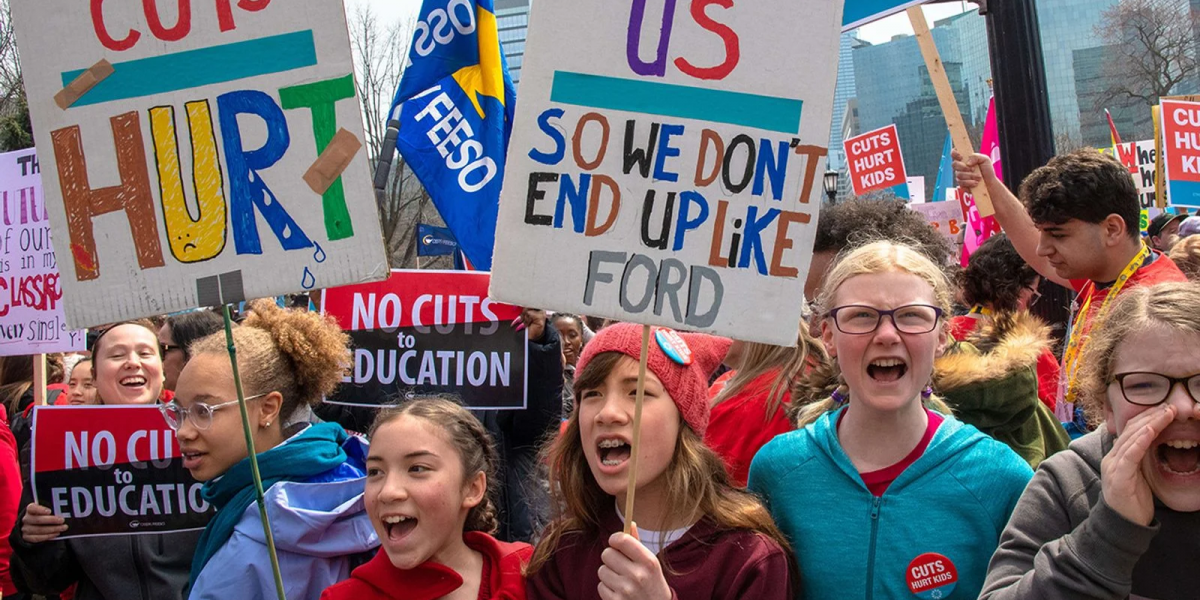The bargaining committee representing public elementary school teachers in Ontario has reached a tentative contract deal with the provincial government.
“This agreement brings us one step closer to ensuring there will be no province-wide job actions or strikes in all English-language public schools for the next three years,” boasted Ontario Education Minister Stephen Lecce in a statement.
The agreement would apply to over 80,000 elementary and occasional teachers across the province. Members of the Elementary Teachers’ Federation of Ontario (ETFO) had previously voted 95 percent in support of strike action.
ETFO President Karen Brown emphasized, “this has been the longest round of central bargaining in ETFO’s history, but we persisted. We remained focused on getting government cuts off the table and on addressing members’ working conditions, which are students’ learning conditions.”
What was won, what we still need
The agreement seems like it will do the former, but fails to address the latter. It was successful at keeping benefits, sick leave, pensions and other benefits from being cut, but failed to restore the funding and special teacher positions that were lost in the last round of bargaining. It also does nothing to address class sizes and does the bare minimum to address the epidemic of violence in schools.
In many ways, it feels like this is an agreement meant to buy off members, while leaving classroom conditions as is. The agreement, which will cover the period of 2022 to 2026, will see workers get a retroactive pay bump for the wages constrained by Bill 124 while the issue of wages will move to an arbitrator to decide.
ETFO’s position on teacher salaries that will be referred to arbitration include: COLA (cost of living allowance) plus 1 percent for each year of the four-year agreement, and an increase of daily Occasional Teacher (OT) rates to a minimum of $275 per day and COLA plus 1 percent per year of the collective agreement. Many seem hopeful about the prospect of arbitration, pointing to recent raises by nurses and other public sector workers.
Elsewhere in the agreement, benefits funding will be increased by 7.62 percent upon ratification and will be increased 1 percent for the first three years of the contract and 4 percent in the last year. Sick leave and short term leave and disability would remain unchanged at 11 and 120 respectively. Language around professional judgement, which was under attack from the government earlier in the year, will remain unchanged.
The agreement secures new funding that creates 401 new full time, permanent, specialist teaching positions to support students in Senior Kindergarten and Primary. However, these positions only go half-way to restoring positions that were cut in the last round of bargaining.
The Support for Student Funding is renewed for 2022-2026, which supports 432.7 permanent teaching positions for specialist roles that work directly with students. Once again, this fails to make up for the $1.6 billion that the Ford government cut from the education budget in March 2021. The lack of concrete funding and language to address the roots of violence in our school is frustrating considering the way in which violence in schools was used to rally members and inform our bargaining going into these negotiations. 80 percent of elementary teachers have experienced or witnessed violence, some new posters and status quo funding and class sizes will not do enough to fix that problem.
Building power going forward
By first appearances, this is a decent deal. Not terrible, not great, but enough to get the majority of members to vote yes. The power that OSBCU workers and the labour movement displayed in November 2022 to resist Ford’s anti-strike legislation loomed large over these negotiations. That moment and that movement did a lot to tame a government that, at one time, seemed bent on making further cuts to school working and learning conditions. Now, it seems clear that this government wants to avoid education strikes and this tentative agreement will likely do that by paying teachers while doing very little to improve working conditions.
That this agreement will be enough for the majority of members to vote yes, is a reflection of a certain kind of demoralization in the teachers’ unions. Members don’t believe we can win better teaching conditions, so we settle for improvements to wages. We can’t let the job get any harder. There is already an exodus from the profession that makes it hard to fill jobs with qualified teachers.
We need to look for ways in which we can organize our co-workers around “shop-floor” issues (violence in classrooms, for example), collaborate with other schools and workers in other boards to try and generalize successes and analyze failures. The solidarity and militancy displayed by education workers and the labour movement throughout 2022 should be the inspiration for where we need to go next. This agreement, which is likely to be ratified by ETFO membership, will give teachers three years to try and replicate the kind of solidarity and organization that OSBCU displayed and create the pressure for a united front of teachers unions that we saw in 2019. Building rank-and-file pressure on the leadership will be necessary to push beyond the status quo.
Did you like this article? Help us produce more like it by donating $1, $2, or $5. Donate

